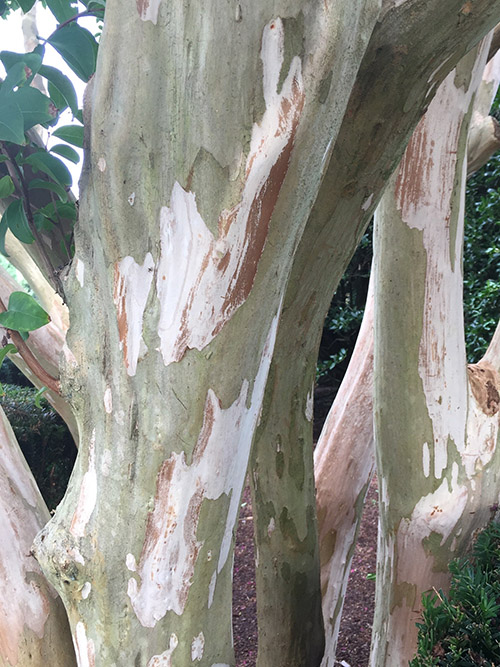Let It Grow
By Tammy Thornton
Flowering trees in early spring give us the first glimmers of hope for new life and great things to come. Most of these encouraging blooms are short-lived and fade away quickly, and our thoughts turn to the perennial garden flowers of spring and summer. On the other side of the season, flowering trees grab our attention once again. Crepe myrtles send summer out with a bang in South Jersey as these vibrant flowering trees lead us through August and into fall. Though they seem late to the party, crepe myrtles wake up just in time to give us a marvelous show as they burst into life with large panicles of colorful, crepe paper-like flowers. Fortunately, unlike their spring-blooming counterparts, crepe myrtles are known for their long-lasting blooms.

Crepe myrtles (also spelled crape myrtles) are well-known trees and shrubs in the southern states. In fact, they are sometimes known as “Lilacs of the South”. Due to warm winters, many gardeners in the southern states find it difficult to grow lilacs, since lilacs need a period of cold dormancy to produce blooms. However, crepe myrtles flourish in the hot south. Living near the shore in South Jersey, we hit that sweet spot in gardening zone 7 of hot summers and cold winters, enabling us to grow both. (Keep in mind how “blessed” we are this winter when you are shoveling snow from your driveway).
Crepe myrtles are among the latest of the deciduous trees to begin leafing out. You may be tempted to knock on their trunk to make sure someone is still in there! My first experience with crepe myrtles came when we bought our house in June over 20 years ago. The large tree in front of our porch seemed to be dormant and missing its bark. Instead, the trunk had a smooth, mottled appearance. When August rolled around, we had the treat of finding out that our “odd tree” was a crepe myrtle, full of beautiful clusters of deep, pink flowers. Although to my naïve eye the tree appeared to be missing its bark, it was actually shedding its bark in patches, showing one of its unique characteristics. As crepe myrtles reach maturity, their bark begins to peel, revealing interesting color variations. Unfortunately, the tree had grown too large to remain so close to the house, though I was able to transplant some of the saplings in our backyard. Most likely, the previous homeowners had no idea their lovely tree would grow so large.
This brings us to an unpleasant subject. Many crepe myrtle owners underestimate the potential size of their trees. Though there are dwarf and mid-sizes varieties of crepe myrtles, some can grow as tall as 25 feet or more. In an attempt to reign in this unexpected growth, gardeners commit what has come to be known as “crepe murder”. First coined by Southern Living magazine around 1997, the phrase refers to the drastic pruning of crepe myrtle trees, resulting in an unnatural, sickly-looking, regrowth of branches. Some of these “gardening crimes” are committed unintentionally by well-meaning otherwise good people, who thought they were taming their trees, by topping them off, or pruning them to encourage blooms. Instead of lopping off the entire top of the tree, use a conservative approach by only thinning out branches to allow circulation, and also removing any damaged or dead branches. The goal is to allow the tree to keep its beautiful natural shape. When in doubt, consult a trusted arborist. Most importantly, do your homework before you purchase a crepe myrtle. Find out its potential size and be sure you have room for the tree at maximum growth.

Crepe myrtles bloom best in full sun. Once established, they are fairly drought tolerant. Flowers can be white, pink, purple, or red, and every shade in between. By deadheading flowers, you may get a second flush of blooms. After flowering, crepe myrtles will form interesting seed pods. In the fall, leaves will turn shades of red, yellow, and orange. Though these sleepy-heads are slow to wake up from their dormancy, making you wonder if they made it through the bleak mid-winter, they will finally spring to life and reward your wait with long-lasting showy blooms late into the growing season. On top of all that, they are deer-resistant. Consider growing this interesting flowering tree in your garden, for many years of beautiful late-season blooms.
Tammy Thornton lives with her husband, children, and crazy pets while enjoying a life of gardening, cooking, and going to the beach.










